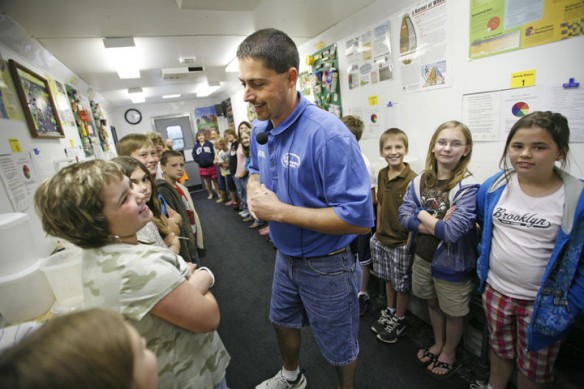
Mobile Science Activity Center program coordinator Jason Hodge instructs students on the ice cream-making process before they begin the activity at Tollesboro Elementary School (Lewis County). Photo by Amy Wallot; May 24, 2011
By Susan Riddell
Students at Tollesboro Elementary School (Lewis County) measured, mixed and shook recently while preparing homemade ice cream, but they weren’t in the school kitchen, cafeteria or even their classroom.
Instead, they were out behind the school inside the Kentucky Department of Agriculture’s (KDA) Mobile Science Activity Center (MSAC).
The Mobile Science Activity Center, a 42-foot-long trailer with 10 workstations, provides students opportunities to investigate agriculture and the environment. Jason Hodge, MSAC program coordinator for KDA, said he routinely sees between 15,000 and 20,000 students a year while covering his assigned region of the state.
All activities in the center use scientific inquiry and align with core content.
“There is something for everybody,” Hodge said. “The kids really enjoy this opportunity, and they are learning the whole time.”
Angela Feezor is a National Board Certified 4th-grade science teacher at Ballard County Elementary School and said Hodge is very knowledgeable of content and teaches to the students’ levels.
“He also incorporates higher-level thinking questions for the students to ponder,” Feezor said. “He keeps students of all levels and abilities active and involved. In most stations, kids not only go home with extended knowledge of the agricultural content but also with something they made while in the Mobile Science Activity Center.”
Feezor’s students have participated in the science center the last three years. She said her favorite demonstration to date has been one about weathering and erosion.
Tollesboro Elementary students made environmentally friendly, biodegradable bouncy balls using corn starch, corn oil and water last year, and that was a big hit according to 4th-grade teacher Crystal Thayer. So was making ice cream recently.
“This event culminated a lot of lessons for us,” Thayer said. “Earlier we graphed favorite ice cream flavors and studied the food chain to see how energy transfers to food. From the process of making the ice cream, students are following directions, recording data and seeing the results.
“They also have to think and adjust,” Thayer added. “One student can’t eat sugar, so he had to leave that ingredient out and still get an end product.”
While Hodge challenges students to know the difference between solutions and mixtures, other key words and phrases also were introduced into the lesson including states of matter, solids, liquids, gases, physical changes, chemical change and freezing point.
Hodge had students hypothesize how many minutes it would take the ice cream to freeze and how many times they would have to shake their buckets that contained ice and salt plus the bag containing milk, sugar and vanilla. (It takes roughly seven minutes.)
Thayer said her students will follow up the lesson by using mean and median to come up with the average number of bucket shakes required. They also will graph findings in a variety of ways.
As students sampled their ice cream, Thayer kept a handful of students thinking about ways to change the process in case they wanted to add strawberries or Reese’s Peanut Butter Cups to the ice cream. She asked them when would be the best time to add ingredients, either before or after the ice cream is frozen, and they discussed the best times to do this for several other ingredients, too.
Feezor said the Mobile Science Activity Center works because it offers hands-on and real world experience, all while keeping students’ attention.
When the Tollesboro Elementary students were making ice cream, they were so eager and engaged, one student nearly poured 1/4 cup of salt needed for the bucket of ice into his mixture of milk, vanilla and sugar.
Hodge saw this about to happen and explained why adding salt to the mixture would ruin the ice cream for that student.
Participating teachers like Thayer and Feezor must complete an orientation prior to a school visit from the Mobile Science Activity Center. Schools pay $100 per day for a visit and can use the MSAC up to three days per school year.
“Having the mobile center come here is a blessing for us,” Thayer said. “Every year, we normally take the kids to Frankfort, but the funding wasn’t there this year. It’s a great opportunity for them to learn something they can use later on and not just in the classroom.”
With the Mobile Science Activity Center making annual school visits, the Kentucky Department of Agriculture is constantly updating lessons so students get something new out of it each time. Coordinators will, however, always have the favorite lessons available for schools participating for the first time.
“Our coordinators, Jeff Harrod and Jason Hodge, attended the National Agriculture in the Classroom Conference in June to get ideas for activities we need to freshen up and for new activities,” said KDA’s Elizabeth McNulty, who works in agriculture education. “We plan to look at some things this summer to update, but will always have our popular lessons: gluep, lip balm, ice cream, etc.”
McNulty said KDA also is monitoring the latest changes in core academic standards.
“We are keeping a close eye on standards changes as they occur and will definitely keep all of our lessons updated with what teachers need to teach in the classroom,” McNulty said. “We are consulting teachers to help us make the program most useful for them and as aligned as it can be.”
MORE INFO …
Elizabeth McNulty, elizabeth.mcnulty@ky.gov, (502) 564-4696









Leave A Comment